|
The last Hessequa were forced
to settle in mission stations during the first decade of the
Twentieth Century. They were a clan of the southern Khoikhoi
(Hottentots), nomadic stone age shepherds. (The missions still exist
as working institutions, are beautiful and worth visiting. Some are
Eighteenth Century and little has changed. They are time capsules.)
At the same time, the very last of the /Xam San hunters (southern
Bushmen) were wandering, broken, on white man's land, or into
villages to beg. The hunting ages were over.
Collectively known as the Khoi-san, for they were really specialists
in economic niches from the same biological group, their origins are
obscure. However their ancesters were certainly present here 10 000
years ago, and these ancesters evolved from people in the region
whose remains are as old as 100 000 years.
We are probably all descended from early Khoi-san.
After the bulk of the Khoi-san had gone, there remained small family
groups and individuals working for white landowners, speaking a
pidgin Dutch, later to be known as Afrikaans. Today these people are
generalised as "Coloureds" and are very numerous in the countryside
of the Cape.
Yet still you will hear old strange-sounding names of plants, places
and animals. Like "Tsitsikamma" (a region), "dwyka" (a lioness), or
"ghwarrie" (a type of tree). Their knowledge of herbs and medicinal
plants is great, yet largely undocumented. They are good trackers.
Many of the people are still illiterate, and might well remain so
for another generation.
The Khoikhoi herders left little behind, but the San hunters left
their rock art. Dating from between thousands and perhaps less than
a hundred years ago, this art provides a near-continuous link with
the Neolithic, and recent research here may well contribute to a
better understanding of prehistoric rock art in the northern
hemisphere.
The first thing to understand is that it is not literal in our
modern sense. Where we distinguish between reason and conjecture,
primitive people saw everything in a unified vision. Myth, spirit
and reality are mixed up and one. The San had a shamanistic culture,
in which every individual was to a greater or lesser extent a
shaman. They lived in a spirit-animated world, daily, nightly, awake
and asleep.
The rock art of the Karoo is
typical. It presents us with an intimate vision of the hunters in
daily trance. In trance they would follow the herds of game, see
rain-animals gathering in distant skies, find springs in the dry
land, and perhaps visit long lost relatives. The paintings show
lines of dots emerging from an animal's head and rising into the sky
- the spirit of a shaman inhabiting an animal's body. Men losing
their legs and flying. Men with antelope heads. Fish with the faces
of men. Hunters killing an animal from which rain pours.
When we discovered the rock art site on
our land we also found a campsite. Pottery shards, fragments of
flint and ostrich eggshell beads lie on the sand. Maybe one day it
will be excavated, but in the mean while, we'll let it lie.
Rock Art
The Bushmen spent hours
observing the wild animals around them until they, more than any
other southern African tribe, had an intimate knowledge of the
animal’s behaviour, whereabouts and movements. Fortunately the
Bushmen expressed their appreciation of their environment and their
beliefs and rituals in beautiful rock paintings all over South
Africa. With their rock art they turned the South African
countryside into one big open-air art gallery for those who came
after them to enjoy!
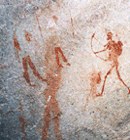
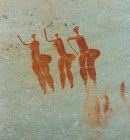
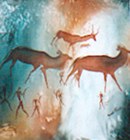
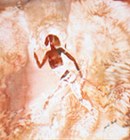
Historical background
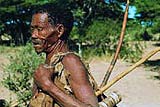 The
Bushmen were gradually replaced by agropastoralists whose presence
dates back to little more than 2 000 years ago. The first of these
groups, the KhoiKhoi (Hottentot) people, settled in the Western Cape
area. The KhoiKhoi herded cattle and sheep and had a social
structure completely different from that of the Bushmen. There was,
however, a lot of interaction between the two groups, so much so
that linguists later classed both their languages as “Khoisan”.
The KhoiKhoi were later followed by the first influx of black people
from the north. The
Bushmen were gradually replaced by agropastoralists whose presence
dates back to little more than 2 000 years ago. The first of these
groups, the KhoiKhoi (Hottentot) people, settled in the Western Cape
area. The KhoiKhoi herded cattle and sheep and had a social
structure completely different from that of the Bushmen. There was,
however, a lot of interaction between the two groups, so much so
that linguists later classed both their languages as “Khoisan”.
The KhoiKhoi were later followed by the first influx of black people
from the north.
Co- Existence
with other Tribes
At first the
Bushmen co-existed peacefully with these Ngunispeakers (the
Zulu,
Xhosa,
Swazi and Ndebele) who intermarried with
the Bushmen and also incorporated some of the distinctive and
characteristic “clicks” of the Bushmen language into their own
languages. Contact with Nguni and Sotho-Tswana
farmers was depicted in the Bushmen’s rock art. The artists
started including representations of cattle and sheep as well as of
people with shields and spears, in their paintings. The most severe
threat to the Bushmen’s survival came in the form of the white
settler farmers and later colonial rule.
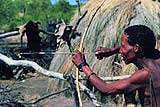 Colonialism
destroyed the Bushmen's nomadic way of life, they were no longer
allowed to roam freely and trophy hunters destroyed the vast herds
of game that formed their principal supply of food. Both Black and
White farmers built up huge herds of cattle that destroyed the veld
foods that had been the Bushmen’s staple diet for centuries. Colonialism
destroyed the Bushmen's nomadic way of life, they were no longer
allowed to roam freely and trophy hunters destroyed the vast herds
of game that formed their principal supply of food. Both Black and
White farmers built up huge herds of cattle that destroyed the veld
foods that had been the Bushmen’s staple diet for centuries.
Enslavement and sometimes mass destruction of Bushmen communities,
by both White and Black farmers, followed. Many became farm
labourers and some joined Black groups and intermarried with them,
which added to the destruction of the social identity of the San
people. |

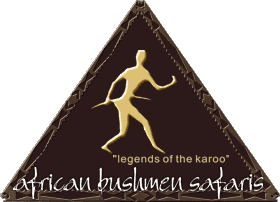




 The
Bushmen were gradually replaced by agropastoralists whose presence
dates back to little more than 2 000 years ago. The first of these
groups, the KhoiKhoi (Hottentot) people, settled in the Western Cape
area. The KhoiKhoi herded cattle and sheep and had a social
structure completely different from that of the Bushmen. There was,
however, a lot of interaction between the two groups, so much so
that linguists later classed both their languages as “Khoisan”.
The KhoiKhoi were later followed by the first influx of black people
from the north.
The
Bushmen were gradually replaced by agropastoralists whose presence
dates back to little more than 2 000 years ago. The first of these
groups, the KhoiKhoi (Hottentot) people, settled in the Western Cape
area. The KhoiKhoi herded cattle and sheep and had a social
structure completely different from that of the Bushmen. There was,
however, a lot of interaction between the two groups, so much so
that linguists later classed both their languages as “Khoisan”.
The KhoiKhoi were later followed by the first influx of black people
from the north. Colonialism
destroyed the Bushmen's nomadic way of life, they were no longer
allowed to roam freely and trophy hunters destroyed the vast herds
of game that formed their principal supply of food. Both Black and
White farmers built up huge herds of cattle that destroyed the veld
foods that had been the Bushmen’s staple diet for centuries.
Colonialism
destroyed the Bushmen's nomadic way of life, they were no longer
allowed to roam freely and trophy hunters destroyed the vast herds
of game that formed their principal supply of food. Both Black and
White farmers built up huge herds of cattle that destroyed the veld
foods that had been the Bushmen’s staple diet for centuries.